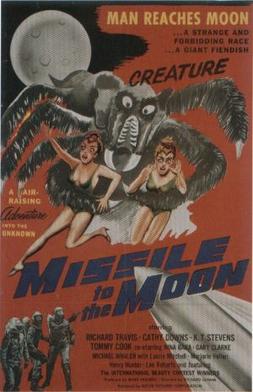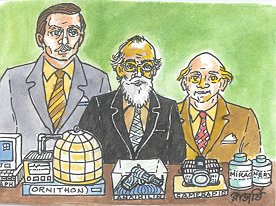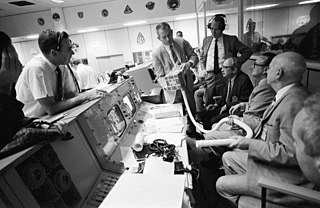
The Defense Advanced Research Projects Agency (DARPA) is a research and development agency of the United States Department of Defense responsible for the development of emerging technologies for use by the military.

Konstantin Eduardovich Tsiolkovsky was a Russian and Soviet rocket scientist who pioneered astronautics. Along with Hermann Oberth and Robert H. Goddard, he is one of the pioneers of space flight and the founding father of modern rocketry and astronautics. His works later inspired Wernher von Braun and leading Soviet rocket engineers Sergei Korolev and Valentin Glushko, who contributed to the success of the Soviet space program. Tsiolkovsky spent most of his life in a log house on the outskirts of Kaluga, about 200 km (120 mi) southwest of Moscow. A recluse by nature, his unusual habits made him seem bizarre to his fellow townsfolk.

Wernher Magnus Maximilian Freiherr von Braun was a German-American aerospace engineer and space architect. He was a member of the Nazi Party and Allgemeine SS, the leading figure in the development of rocket technology in Nazi Germany, and later a pioneer of rocket and space technology in the United States.

Operation Paperclip was a secret United States intelligence program in which more than 1,600 German scientists, engineers, and technicians were taken from former Nazi Germany to the U.S. for government employment after the end of World War II in Europe, between 1945–59. Some were former members and leaders of the Nazi Party.

The Air Force Research Laboratory (AFRL) is a scientific research and development detachment of the United States Air Force Materiel Command dedicated to leading the discovery, development, and integration of direct-energy based aerospace warfighting technologies, planning and executing the Air Force science and technology program, and providing warfighting capabilities to United States air, space, and cyberspace forces. It controls the entire Air Force science and technology research budget which was $2.4 billion in 2006.

Missile to the Moon is a 1958 independently made American black-and-white science fiction film drama, produced by Marc Frederic, directed by Richard E. Cunha, that stars Richard Travis, Cathy Downs, and K. T. Stevens. The film was distributed by Astor Pictures and is a remake of an earlier Astor Pictures-distributed film, Cat-Women of the Moon (1953). Missile to the Moon was released in late 1958 as a double feature with Cunha's Frankenstein's Daughter.

A small satellite, miniaturized satellite, or smallsat is a satellite of low mass and size, usually under 1,200 kg (2,600 lb). While all such satellites can be referred to as "small", different classifications are used to categorize them based on mass. Satellites can be built small to reduce the large economic cost of launch vehicles and the costs associated with construction. Miniature satellites, especially in large numbers, may be more useful than fewer, larger ones for some purposes – for example, gathering of scientific data and radio relay. Technical challenges in the construction of small satellites may include the lack of sufficient power storage or of room for a propulsion system.

Professor Trilokeshwar Shonku is a fictional scientist and inventor created by Satyajit Ray in a series of Bengali science fiction books of the same name published from 1965 on. He is the central protagonist of the series. Professor Shonku resides in Giridih. His house contains a laboratory, and he lives with his pet cat, Newton, named after Sir Isaac Newton and his man-servant, Prahlad. He was born in the year of 1912 but his year of death is unknown.
Neanderthals have been depicted in popular culture since the early 20th century. Early depictions conveyed and perpetuated notions of proverbially crude, low-browed cavemen; since the latter part of the 20th century, some depictions have modeled more sympathetic reconstructions of the genus Homo in the Middle Paleolithic era. In popular idiom, people sometimes use the word "Neanderthal" as an insult - to suggest that a person so designated combines a deficiency in intelligence and a tendency to use brute force. The term may also imply that a person is old-fashioned or attached to outdated ideas, much in the same way as the terms "dinosaur" or "Yahoo".
Monarch Books was an American publishing firm in the late 1950s/early 1960s which specialised in pulp novels. Some of these, like Jack the Ripper (1960), were movie tie-ins.
Understanding is a documentary television series that aired from 1994 to 2004 on TLC. The program covered various things understood from a scientific perspective and was narrated by Jane Curtin, Candice Bergen, and Peter Coyote. It originally aired on TLC and as of 2013 is currently being shown on the Science Channel. The series is presented in a similar fashion to two other programs that also show on the Science Channel, Discover Magazine and Megascience.

Sundancer was the proposed third prototype space habitat intended to be launched by Bigelow Aerospace—and the first human-rated expandable module based on TransHab technology acquired from NASA. It was to have been used to test and confirm systems used in the company's commercial space station efforts during the early 2010s, and if successful, would have formed the first piece of the proposed commercial space station.

Aerospace engineering is a discipline of engineering regarding the design, development, testing, and production of aircraft, spacecraft, and related systems that travel through a fluid. Aerospace engineering employs mechanical and physical concepts from aeronautics, propulsion, avionics, materials science, structural analysis, and manufacturing..
The Department of Mad Scientists: How DARPA is Remaking Our World, from the Internet to Artificial Limbs, is a book by Michael Belfiore about the history and origins of DARPA. Belfiore describes DARPA's creation as the agency ARPA in Department of Defense and some of its notable contributions to artificial limbs, the Internet, space exploration and robotic automobiles.
The 100 Year Starship project (100YSS) was a one-year joint U.S. Defense Advanced Research Projects Agency (DARPA) and National Aeronautics and Space Administration (NASA) effort "to take the first step in the next era of space exploration—a journey between the stars". The study explored development of a viable and sustainable model for persistent, long-term, private-sector investment into the myriad of disciplines needed to make interstellar space travel practicable and feasible. The goal was to examine what it would take — organizationally, technically, sociologically and ethically — to develop the ability to send humans to another star within 100 years. The study culminated in a $500,000 grant awarded to a consortium under the lead of the Dorothy Jemison Foundation for Excellence, which led to the creation of an independent organization inheriting the name 100 Year Starship from DARPA. Annual 100YSS symposia were organized from 2011 to 2015, and again in 2023.
Flometrics is a San Diego based engineering company that was formed in the garage of Dr. Steve Harrington in 1990. The engineers specialize in thermodynamics and fluid dynamics, but were widely publicized for launching a rocket running on a biofuel "developed by the EERC under a DARPA contact."

Space Station 13, often shortened to SS13, is a top-down tile-based action role-playing multiplayer video game running on the freeware BYOND game engine, originally released in 2003.

Vinita Marwaha Madill is a British Space Operations engineer and science communicator. She is based at the European Space Agency through TERMA B.V. in the Netherlands, where she is responsible for the development of the European Robotic Arm. She founded the platform Rocket Women, which uses stories and interviews to encourage women to study STEM.

Bruce Bugbee is an American scientist. His work includes research into space farming with NASA and at Utah State University, where he is the Director of the Crop Physiology Laboratory.












